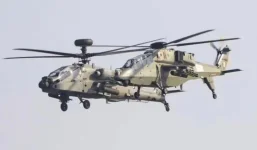- Views: 935
- Replies: 18

The Indian Army is poised for a significant boost in its offensive capabilities with the imminent arrival of six AH-64 Apache attack helicopters from Boeing. These formidable aircraft will feature a distinctive sand camouflage paint scheme tailored to the arid conditions of western India, enhancing their survivability in the region.
Sand camouflage, often referred to as desert camouflage, employs a mix of light brown, tan, and sometimes green tones. This color palette closely mimics the natural hues of sandy terrain and rocky formations, making the helicopters more difficult for enemy forces on the ground to visually identify. The camouflage effectively disrupts the helicopter's outline, particularly at a distance, improving its chances of survival.
The Indian Army intends to primarily station these Apaches in the Thar Desert, situated along the western border with Pakistan. This region's sparse vegetation provides limited natural concealment for aircraft, making sand camouflage a critical advantage. However, the effectiveness of this camouflage would be lessened in regions of northern India, characterized by lush greenery or snow cover.
Sand camouflage, while a valuable tool, is only one aspect of a broader strategy. Modern militaries utilize advanced detection technologies, including radar and infrared scanners, that can potentially pierce camouflage. The Indian Army will likely rely on a combination of tactics, such as low-level flying and meticulously planned flight routes, to further minimize the Apaches' detection risk.
The introduction of these Apaches, enhanced by their strategic desert camouflage, marks a noteworthy development in the Indian Army's offensive capabilities, particularly along its western borders. This move demonstrates India's ongoing commitment to bolstering its defence capabilities and maintaining a tactical advantage in the ever-evolving landscape of modern warfare.

